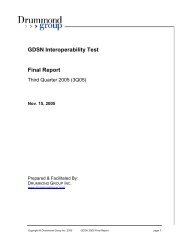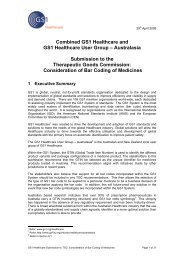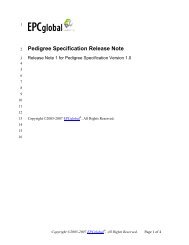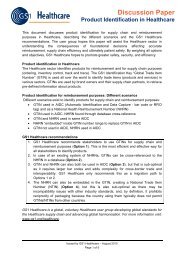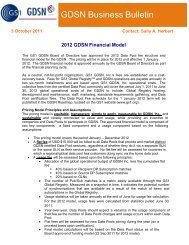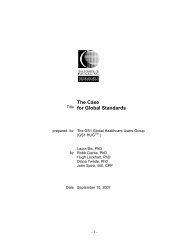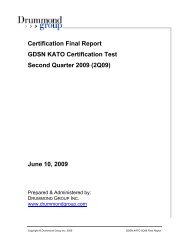SBDH Technical Implementation Guide - GS1
SBDH Technical Implementation Guide - GS1
SBDH Technical Implementation Guide - GS1
Create successful ePaper yourself
Turn your PDF publications into a flip-book with our unique Google optimized e-Paper software.
Standard Business Document Header (<strong>SBDH</strong>) Version 1.3 - <strong>Technical</strong> <strong>Implementation</strong> <strong>Guide</strong><br />
■<br />
tel:863-1234;phone-context=+1-914-555: The URI describes a local phone number that is<br />
valid within a particular phone prefix.<br />
5.2. The use of the token ‘EAN.UCC’ instead of ‘<strong>GS1</strong>’<br />
For legacy reasons and to support existing implementations of <strong>GS1</strong> XML standards, the token<br />
‘EAN.UCC’ has been recommended for the [<strong>SBDH</strong>] elements ‘Authority’ and ‘Standard’. At a future<br />
date when a new major version of <strong>GS1</strong> XML standards will be created (version 3.0) all references to<br />
the token ‘EAN.UCC’ associated with <strong>GS1</strong> XML standards and document shall be replaced with the<br />
token ‘<strong>GS1</strong>’. Since these guidelines have been formulated after the adoption and implementation of<br />
<strong>GS1</strong> XML in the user community, the token ‘EAN.UCC’ currently in use must be used.<br />
5.3. Next version of UN/CEFACT <strong>SBDH</strong> specification<br />
At the time of writing of this guideline document UN/CEFACT Applied Technologies Group 2 (ATG2)<br />
had initiated a number of new working groups by submission of the project proposals to the<br />
UN/CEFACT Forum Management Group (FMG). Most of these new projects have been endorsed by<br />
the FMG and work has begun. One of the projects is the new version of the Standard Business<br />
Document Header.<br />
Some of the objectives of this project are:<br />
■ Bring [<strong>SBDH</strong>] into Core Components <strong>Technical</strong> Specification (CCTS) version 3.0 compliance<br />
■ Submit <strong>SBDH</strong> content to the Trade and Business Processes Group (TBG) for formal approval<br />
of the content and additional harmonization<br />
■ Submission of the <strong>SBDH</strong> methodology and processing part to the UN/CEFACT Core<br />
Component Message Assembly (CCMA) group and cooperation with Techniques and<br />
Modeling Group (TMG), because ATG2 has identified that many aspects are syntax<br />
independent and have an impact in the message assembly<br />
■<br />
■<br />
XML syntax serialization of the CCTS based [<strong>SBDH</strong>] according to the XML Naming and<br />
Design Rules (XMLNDR) version 3.0. In short create the new <strong>SBDH</strong> schemas.<br />
Further direction of the [<strong>SBDH</strong>]<br />
In brief the purpose of this project is to create a new version of the <strong>SBDH</strong> specification and related<br />
XML schemas that are harmonized with all other methodologies and specifications from UN/CEFACT.<br />
The current [<strong>SBDH</strong>] is a standalone specification and is not compliant with the in-development CCTS<br />
and XMLNDR version 3.0 specifications. Since this project is work in progress it has no bearing on this<br />
implementation guide which is based on the currently adopted [<strong>SBDH</strong>]. At some future date when the<br />
<strong>GS1</strong> user community is ready to implement the then new version of the <strong>SBDH</strong> specification, only then<br />
will <strong>GS1</strong> adopt the new version of the <strong>SBDH</strong> specification.<br />
5.4. Serialization<br />
Serialization actually is the requirement for sequencing/choreography of messages in a particular<br />
business process to determine processing order of messages. There’s a need for serialization of <strong>GS1</strong><br />
XML messages in the upstream business processes being implemented by GUSI trading partners.<br />
The question asked is if [<strong>SBDH</strong>] provides any support for serialization of messages.<br />
<strong>SBDH</strong> is a simple header and does not provide a mechanism for identifying sequencing information at<br />
the header level. An example of serialization is, a newer order in the sequence replaces the older in<br />
the message choreography between 2 trading partners. Sequencing requires business intelligence at<br />
payload level / backend application system and is a characteristic of the business process rather than<br />
transaction management at the middleware. In short Serialization is dependant on the business<br />
process and should be handled in the business document rather than the header/envelope. If<br />
July-2007, Issue 1 All contents copyright © <strong>GS1</strong> 2007 Page 17 of 21






